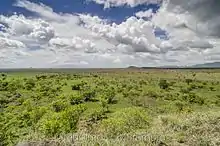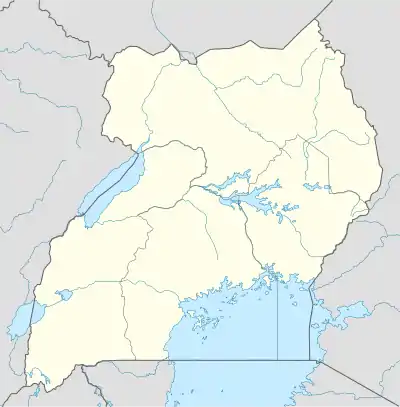Pian Upe Wildlife Reserve
The Pian Upe Wildlife Reserve is a conservation area in the Karamoja subregion of northeastern Uganda. It is the second largest conservation protected area in Uganda.[1]

| Pian Upe Wildlife Reserve | |
|---|---|
IUCN category IV (habitat/species management area) | |
 | |
| Location | Moroto District |
| Nearest city | Mbale |
| Coordinates | 1°51′N 34°17′E |
| Area | 2,275 square kilometres (878 sq mi) |
| Governing body | Uganda Wildlife Authority |
Location
Pian Upe is located in the North Eastern part of Uganda in Nakapiripiti district with a total of about 8 other districts either closely or partly covered by the stretch of the game reserve, these districts include: Amudat, Moroto, Katakwi, Napak, Kween, Kumi, Bukedea, and Bulambuli.[2] The little known reserve extends over 2,788 kilometers of semi-arid country to the north of Mount Elgon.[3]
Name Origin
Pian Upe derives its name from its community where “Pian” refers to a clan among the Karamajong people of north-eastern Uganda while “Upe” refers to a Kalenjin speaking pastoral community of the Karamongs who are said to have originated from the Pokot tribe in Kenya, but now settled close to the wildlife reserve in Amudat district. “Pian” actually means “calm hearted people” while “Upe” means “enemy”, when both words are combined, you get a word “friendly enemies”. [2]
History
The southern part of the reserve was gazetted as the Debasien Animal Sanctuary in 1958.[4] A government-led project to convert land just south of the Greek River for agriculture threatened the viability of wildlife conservation in the whole area.[5] In 1964 the area was expanded northward and renamed Pian-Upe Game Reserve.[1]
A 2003 proposal to degazette the reserve in order to farm fruit on the land was blocked.[6]
Geology
There is a hot spring potential for Geothermal tapping at Cheposukunya. Further to that, there are Mercury wells at Mt. Kadam.
The reserve features semi arid climate with one rain season annually.
Biology
Plants
Most of the reserve is covered by undisturbed grassland and wooded grassland. Small areas of riverine woodland, kopjes also exist. Some land is cultivated, and especially the area near the Greek River is threatened by conversion.[1]
Dominant tree species are red acacia and desert date. Also present are bushwillows, Harrisonia abyssinica and red spike-thorns. Shrubs include butterfly pea and wooly caper bush. Cultivated areas have many live fences of yellow oleander.[1]
Common grasses in the grassland are thatching grass and bristle species. Less common are beard grasses and lemon grasses. Along the rivers Vlei bristle grass and red nut sedge dominate. The lower vegetation layer burns every year.[1]
Large mammals
Although the area once supported healthy populations of lions, elephants, black rhinos and giraffes, these are now locally extinct. The last giraffe was reportedly poached in 1995. In October 2019 15 giraffes from Murchison Falls National Park where reintroduced in the reserve by UWA. Populations of plains zebra, common eland, are also threatened Grants gazelle.[1]
The most commonly sighted mammal in the reserve is the oribi. Others known to inhabit the area (as of 1996) include:[1]
|
Reptiles
Pian Upe is home to enormous rock pythons and smaller but venomous puff adders. Harmless water snakes are also found there.
The largest lizards in Pian Upe are the Savannah monitors. Others in the reserve include the common agama as well as skinks, chameleons and geckos.[1]
References
- Zwick, Karen; Duncan Sivell; Rich Bamlett; Ian Devon; Julia Lloyd; Helen MacGregor; Lee Stewart (1998). "Pian-Upe Wildlife Reserve Biological and socio-economic survey" (PDF). Kampala: Uganda Wildlife Authority. ISSN 1748-3697. Archived from the original (PDF) on 2013-08-23. Retrieved 2012-06-26.
{{cite journal}}: Cite journal requires|journal=(help) - "Pian Upe Wildlife Reserve". Pian Upe Wildlife Reserve. Retrieved 2022-03-04.
- Briggs, Philip (2016). Uganda: The Bradt Travel Guide. England: Bradt Travel Guides Ltd. p. 279. ISBN 9781784770228.
- Kinloch, Bruce (1972). The shamba raiders : memories of a game warden (2 ed.). Hampshire: Ashford. p. 254. ISBN 9781852530358.
- Harthoorn, Antonie Marinus (1970). The flying syringe: Ten years of immobilising wild animals in Africa (PDF). Bles. p. 287. ISBN 978-0713802788.
- World Resources Institute (December 2010). "Land for Private Investors and Economic Development" (PDF): 1–4. Retrieved 26 June 2012.
{{cite journal}}: Cite journal requires|journal=(help)